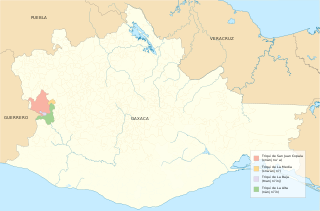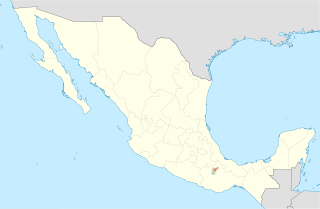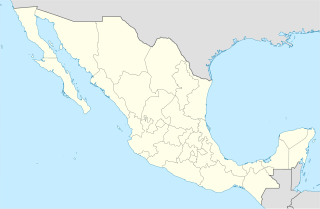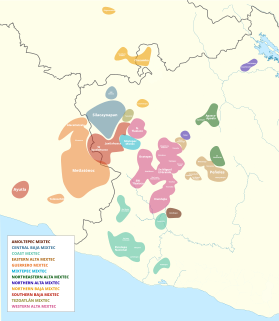San Juan[saŋ ˈxwan], Spanish for Saint John, may refer to:

The Mixtecs, or Mixtecos, are indigenous Mesoamerican peoples of Mexico inhabiting the region known as La Mixteca of Oaxaca and Puebla as well as the state of Guerrero's Región Montañas, and Región Costa Chica, which covers parts of the Mexican states of Oaxaca, Guerrero and Puebla.

The Triqui, or Trique, languages are a family of Oto-Manguean spoken by 30,000 Trique people of the Mexican states of Oaxaca and the state of Baja California in 2007. They are also spoken by 5,000 immigrants to the United States. Triqui languages belong to the Mixtecan branch together with the Mixtec languages and Cuicatec.

Cuicatec is an Oto-Manguean language spoken in Oaxaca, Mexico. It belongs to the Mixtecan branch together with the Mixtec languages and the Trique language. The Ethnologue lists two major dialects of Cuicatec: Tepeuxila Cuicatec and Teutila Cuicatec. Like other Oto-Manguean languages, Cuicatec is tonal.

The Sierra Madre de Oaxaca pine–oak forests is a tropical and subtropical coniferous forests ecoregion in Southern Mexico.

The Sierra Madre de Oaxaca is a mountain range in southern Mexico. It is primarily in the state of Oaxaca, and extends north into the states of Puebla and Veracruz.

XEOJN-AM is an indigenous community radio station that broadcasts in Spanish, Mazatec, Cuicatec and Chinantec from San Lucas Ojitlán, in the Mexican state of Oaxaca. It is run by the Cultural Indigenist Broadcasting System (SRCI) of the National Commission for the Development of Indigenous Peoples (CDI). The frequency is 950 kHz.

San Juan Tepeuxila is a town and municipality in Oaxaca in south-western Mexico. The municipality covers an area of 366.16 km². It is part of Cuicatlán District in the north of the Cañada Region.

Cuicatlán District is located in the south of the Cañada Region of the State of Oaxaca, Mexico. The district includes 20 municipalities, bringing together a total of 233 settlements.
Chevé Cave is a deep cave located in the Sierra Juárez mountain range in the southern Mexico state of Oaxaca. As of 2003, its deepest point has been measured at 4,869 feet (1,484 m) deep, making it the second deepest known cavern in Mexico and the Western Hemisphere, as well as the world’s 12th deepest cave. The cave's deepest known point is nearly one vertical mile and seven horizontal miles from the entrance, ending in a terminal sump. The present limit of exploration in Chevé, at 9.3 kilometers from the nearest entrance, represents one of the most remote locations ever attained inside any cave on Earth. The logistics of reaching this point are enormous: more than two kilometers of rope need to be rigged and three underground camps established. Chevé is the deepest proven freshwater hydrological system in the world. Temperatures in Chevé are moderate, ranging from 47 to 52 °F. It has been most thoroughly explored under the leadership of caver Bill Stone.

The Indigenous people of Oaxaca are descendants of the inhabitants of what is now the state of Oaxaca, Mexico who were present before the Spanish invasion. Several cultures flourished in the ancient region of Oaxaca from as far back as 2000 BC, of whom the Zapotecs and Mixtecs were perhaps the most advanced, with complex social organization and sophisticated arts.

Huamelulpan is an archaeological site of the Mixtec culture, located in the town of San Martín Huamelulpan at an elevation of 2,218 metres (7,277 ft), about 96 kilometres (60 mi) north-west of the city of Oaxaca, the capital of Oaxaca state.

The Mixtecan languages constitute a branch of the Oto-Manguean language family of Mexico. They include the Trique languages, spoken by about 24,500 people; Cuicatec, spoken by about 15,000 people; and the large expanse of Mixtec languages, spoken by about 511,000 people. The relationship between Trique, Cuicatec, and Mixtec, is an open question. Unpublished research by Terrence Kaufman in the 1980s supported grouping Cuicatec and Mixtec together.

The internal classification of Mixtec is controversial. Many varieties are mutually unintelligible and by that criterion separate languages. In the 16th century, Spanish authorities recognized half a dozen lenguas comprising the Mixtec lengua. It is not clear to what extent these were distinct languages at the time. Regardless, the colonial disintegration of the Mixtec nation and resulting isolation of local communities led to the rapid diversification of local dialects into distinct languages. Below are some attempts at Mixtec classification by various scholars.
Teutila Cuicatec is a language spoken in Oaxaca State, Mexico.
The Cuicatecs are an indigenous people of Mexico. The Cuicatecs traditionally speak the Cuicatec language and are closely related to the Mixtecs. Alongside the Trique and Mixtecan, the Cuicatecs form one branch of the Otomanguean language family.

The Tehuacán-Cuicatlán biosphere reserve is a protected natural area located in southeastern Mexico. Its name derives from its two main locations: Cuicatlán and Tehuacán, in the latter are their administrative offices, covers 490,186 hectares distributed among 21 municipalities in the state of Puebla and Oaxaca.
Muriel Eva Verbitsky de Hunt (1934–1980) was an Argentine cultural anthropologist, academic and writer who moved to the United States in the late 1950s. She is remembered for her contributions to symbolic anthropology and ethnohistory. Together with her husband Robert Hunt, she performed innovative regional work in Oaxaca, Mexico, in the 1960s.












